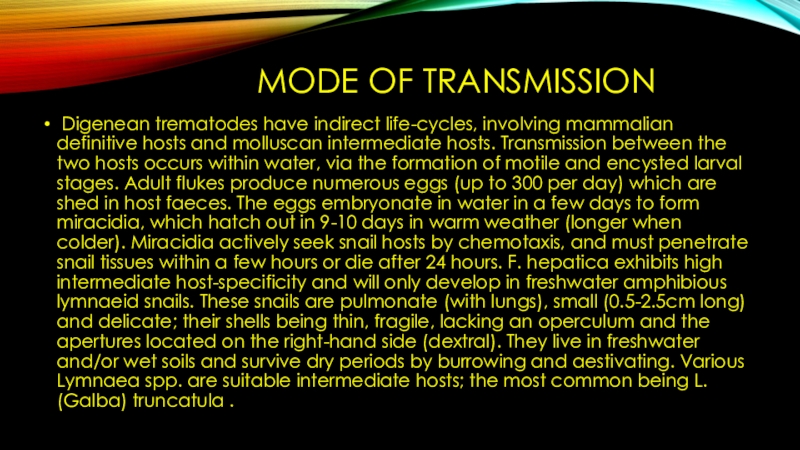Слайд 1FASCIOLA HEPATICA
TROPIC NO: 4
Слайд 3SYSTEMATIC POSITION
KINGDOM : ANIMALIA
PHYLUM : PLATYHELMINTHES
CLASS
: TREMATODA
ORDER : ECHINOSTOMIDA
FAMILY
:Fasciolidae
GENUS :Fasciola
SPECIES : F. HEPATICA
Слайд 4MORPHOLOGY
Morphology: The Adult Worm - Averaging 30mm in length
and 13 mm in width, Fasciola hepatica is one of
the largest flukes in the world. The adult worm has a very characteristic leaf shape with the anterior end being broader than the posterior end and an anterior cone-shaped projection.
Слайд 5GEOGRAPICAL DISTRIBUTION
Fasciola hepatica is found on all inhabited continents, in
more than 70 countries, particularly where sheep or cattle are
raised. Human infections have been reported in parts of Europe, the Middle East, Latin America (e.g., Bolivia and Peru), the Caribbean, Asia, Africa, and rarely in Australia.2 мая 2019 г
Слайд 7pathogenicity
Pathogenesis: Infections have been associated with two types of liver
disease in domestic animals: acute or subacute necrotic disease due
to juvenile flukes; and chronic fibrotic disease due to adult flukes. Penetration of the liver capsule by immature flukes generally does not cause much damage, but their subsequent migration through the liver parenchyma may cause significant necrosis (liver rot). Mass migration of juveniles may produce extensive traumatic tissue damage, coagulative necrosis, haemorrhage, urticaria, eosinophilia, leukocytosis, pallor, anaemia, and can be fatal. Acute infections in sheep can also be complicated by secondary bacterial infection causing clostridial necrotic hepatitis (‘black disease’). Chronic infections by the long-lived adults feeding on the lining of the bile ducts may result in progressive loss of condition, biliary epithelial hyperplasia, duct fibrosis, biliary obstruction and cholangitis, jaundice, and eventually a fibrotic hardened liver. Sheep may become anaemic and emaciated, developing submandibular oedema (bottle-jaw) and ascites.

Слайд 8Mode of transmission
Digenean trematodes have indirect life-cycles, involving mammalian
definitive hosts and molluscan intermediate hosts. Transmission between the two
hosts occurs within water, via the formation of motile and encysted larval stages. Adult flukes produce numerous eggs (up to 300 per day) which are shed in host faeces. The eggs embryonate in water in a few days to form miracidia, which hatch out in 9-10 days in warm weather (longer when colder). Miracidia actively seek snail hosts by chemotaxis, and must penetrate snail tissues within a few hours or die after 24 hours. F. hepatica exhibits high intermediate host-specificity and will only develop in freshwater amphibious lymnaeid snails. These snails are pulmonate (with lungs), small (0.5-2.5cm long) and delicate; their shells being thin, fragile, lacking an operculum and the apertures located on the right-hand side (dextral). They live in freshwater and/or wet soils and survive dry periods by burrowing and aestivating. Various Lymnaea spp. are suitable intermediate hosts; the most common being L. (Galba) truncatula .

Слайд 9Disease and dialyasis
fasciolosis is a parasitic worm infection caused by
the common liver fluke Fasciola hepatica as well as by
Fasciola gigantica. The disease is a plant-borne trematode zoonosis, and is classified as a neglected tropical disease (NTD). It affects humans, but its main host is ruminants such as cattle and sheep.
Слайд 10Prevention and control
: Subacute and chronic infections may be treated
with triclabendazole or bithionol, which show excellent trematocidal activity with
few side-effects. A range of other anthelmintics show variable activity, including carbon tetrachloride, rafoxanide, niclofolan, closantel and oxyclozanide, but their use may be contra-indicated under certain conditions in certain animals. Preventive measures are based on breaking the cycle of transmission by reducing faecal contamination of water bodies, reducing snail populations using molluscicides (usually copper sulphate) or draining swampy fields, restricting access of livestock to aquatic vegetation, and avoiding watercress. Snail control is often difficult, particularly in high rainfall areas where even temporary pools may harbour large snail populations (they aestivate in the ground during dry conditions). Feral or wild animals (such as rabbits) may also continue to act as reservoirs of infection for domestic livestock.